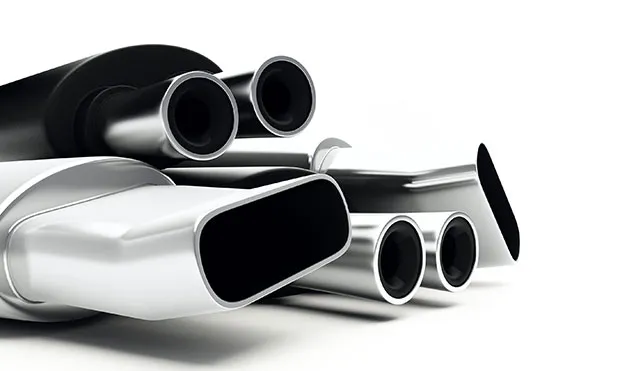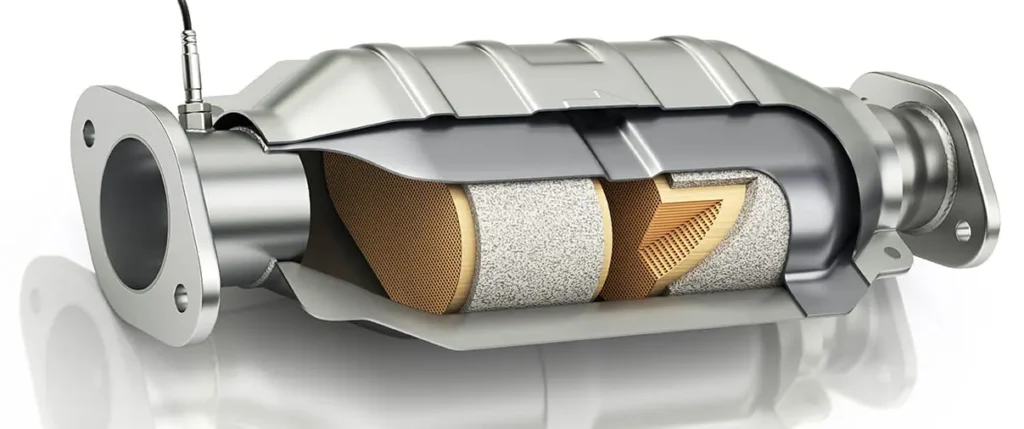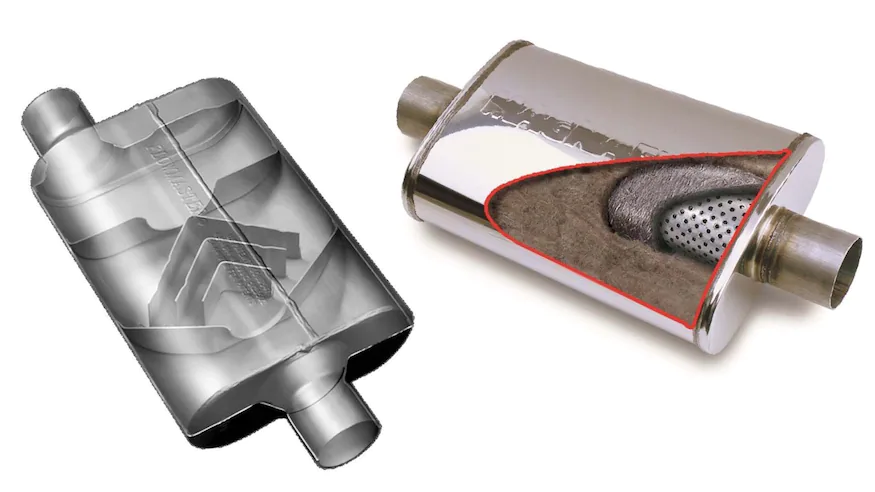The Ultimate Guide to Buying an Exhaust System
An exhaust system is a crucial component of your vehicle, responsible for directing and controlling the flow of exhaust gases away from the engine.
It not only helps to improve your car’s performance and efficiency, but it also plays a significant role in reducing emissions and noise pollution.
Upgrading to a performance exhaust system can bring a host of benefits, including increased horsepower, better fuel economy, and a more aggressive exhaust tone.
In this Complete Buying Guide for Exhaust Systems, we will take a closer look at the different types of exhaust systems available, the factors to consider when making your purchase, and how to choose the right one for your vehicle.
Whether you’re a car enthusiast looking to boost your vehicle’s performance or just looking to replace a worn-out exhaust system, this guide will provide you with all the information you need to make an informed decision.
Choose best Exhaust From Best Exhaust System buying Guide
Benefits of Having Exhaust System Installed
There are several benefits to installing a new aftermarket exhaust system on your vehicle, including:
1.Increased horsepower and torque: A performance exhaust system can improve exhaust flow and reduce backpressure, which can result in an increase in horsepower and torque.
2.Better fuel economy: A properly designed exhaust system can help improve the engine’s efficiency, resulting in better fuel economy.
3.Enhanced sound: Aftermarket exhaust systems are designed to produce a deeper, more aggressive exhaust tone, which can add a sporty and aggressive look to your vehicle.
4.Improved appearance: Aftermarket exhaust systems are often made from high-quality materials and feature polished or chrome-plated finishes that can improve the appearance of your vehicle.
5.Increased durability: Aftermarket exhaust systems are typically made from higher quality materials than stock systems and are often better able to withstand the rigors of daily driving and performance use.
6.Weight reduction: Some aftermarket exhaust systems are made of lightweight materials like titanium and carbon fiber, which can reduce the weight of the vehicle, resulting in better handling and improved performance.
7.Legalization: Some aftermarket exhaust systems are designed to meet emission and noise regulations, which can help ensure that your vehicle is legal to drive on the street.
It’s important to note that not all aftermarket exhaust systems will provide the same benefits and not all exhaust systems are legal in all areas, it’s best to check with your local laws and regulations before buying exhaust systems.
What are basic Parts of a Exhaust System
An exhaust system is a series of parts that channel the exhaust gases from an internal combustion engine to the outside of the vehicle. The basic parts of an exhaust system include:
1.The exhaust manifold:
This is the first component of the exhaust system, located at the engine’s cylinder head. It collects exhaust gases from the cylinder head ports and routes them into the exhaust pipe.
An exhaust manifold is a component of an internal combustion engine that collects exhaust gases from multiple cylinders and directs them to the exhaust pipe.
The exhaust manifold’s main function is to collect the exhaust gases from the engine and route them to the exhaust pipe, which then carries them out of the vehicle.
It also plays a role in the engine’s performance by allowing the exhaust gases to be expelled quickly and efficiently which help to increase the engines power and reduce the pollution.
2.The catalytic converter:
This component is located in the exhaust pipe, and it converts harmful pollutants in the exhaust gases into less harmful substances.
A catalytic converter is an emissions control device that is installed in the exhaust system of an internal combustion engine. It is designed to reduce the emissions of harmful pollutants such as carbon monoxide, hydrocarbons, and nitrogen oxides.
The catalytic converter contains a ceramic or metal substrate that is coated with a mixture of precious metals, such as platinum, palladium, and rhodium. These metals act as catalysts, promoting chemical reactions that convert the harmful pollutants into less harmful substances, such as water vapor and carbon dioxide.
It’s an important component in reducing vehicle emissions and meeting emissions standards set by regulatory bodies such as the Environmental Protection Agency (EPA).
3.The muffler:
The muffler is located in the middle or rear of the exhaust pipe, and its purpose is to reduce exhaust noise.
A muffler is an automotive component that is part of the exhaust system of an internal combustion engine. It is designed to reduce the amount of noise that is generated by the engine by absorbing and dissipating the sound energy of the exhaust gases as they pass through.
The muffler typically consists of a series of perforated tubes or chambers, which are packed with sound-absorbing materials such as fiberglass or steel wool. These materials help to scatter and reflect the sound waves, reducing the amount of noise that is transmitted to the outside of the vehicle.
Mufflers work by using the principles of sound wave reflection, absorption, and cancellation. They can also be used in conjunction with other exhaust system components such as catalytic converters and resonators to improve the performance of the engine and reduce emissions.
It is a mandatory component in most vehicles, as they help in reducing the noise pollution caused by the engine and also improves the overall driving experience.
4.The resonator:
This component may be located before or after the muffler, and its purpose is to reduce any unwanted resonant sounds in the exhaust.
A resonator is a component of an exhaust system that is designed to reduce unwanted noise and vibrations caused by the exhaust gases.
A resonator works by creating a chamber that is tuned to a specific frequency. As the exhaust gases pass through the chamber, the sound waves are reflected back and forth, which helps to cancel out certain unwanted frequencies. This results in a reduction of the exhaust noise that is heard outside the vehicle.
Resonators are commonly used in vehicles to reduce unwanted drone noise that can occur at certain engine RPM ranges. They are typically made of stainless steel or aluminized steel and can be either straight pipe or chamber type, with different designs depending on the vehicle and the desired sound level.
5.The tailpipe:
The tailpipe is the final component of the exhaust system, and it carries the exhaust gases out of the vehicle.
It is the pipe that carries the exhaust gases from the muffler and resonator to the outside of the vehicle. The tailpipe is located at the rear of the vehicle and is usually visible as the pipe that exits from the rear bumper or undercarriage.
The tailpipe serves as the exit point for the exhaust gases and also helps to reduce the noise level of the exhaust system by diffusing the exhaust gases, making them less audible.
Tailpipes can come in different shapes, sizes, and materials, depending on the vehicle and the desired exhaust tone. Some tailpipes are made of stainless steel and are polished to a mirror finish, while others are made of aluminized steel or chrome-plated to improve the appearance of the vehicle.
Tailpipes play an important role in the exhaust system, as they help to dissipate the exhaust gases and reduce exhaust noise, while also serving as an aesthetic feature of the vehicle.
6.Intermediate Pipe:
An intermediate pipe is a component of an exhaust system that connects the exhaust manifold to the catalytic converter or resonator. It is typically located between the engine and the muffler.
Main functions: Connecting the exhaust manifold to the catalytic converter or resonator , Reducing exhaust noise , Improving exhaust flow and Enhancing the vehicle’s appearance.
7.Hangers and Clamps:
In an exhaust system, hangers and clamps are used to secure and support the various components of the exhaust system.
Hangers are typically made of rubber or metal and are used to hold the exhaust pipes, muffler, and tailpipe in place. They are typically attached to the vehicle’s frame or suspension, and are used to hold the exhaust system in place while allowing for some movement as the vehicle goes over bumps or rough roads.
Clamps, on the other hand, are used to secure the joints between the various components of the exhaust system, such as the exhaust manifold, intermediate pipe, catalytic converter, muffler, and tailpipe. They are typically made of metal and are used to clamp the exhaust pipes and other components together, ensuring a tight seal and preventing exhaust leaks.
These are the basic parts of an exhaust system, and the specific components and layout of an exhaust system can vary depending on the make and model of the vehicle.
Types of Exhaust Systems
Exhaust systems come in a variety of types and designs, each with its own set of advantages and disadvantages. Understanding the different types of exhaust systems available will help you make an informed decision when choosing the right one for your vehicle.
1.Cat-back Exhausts:
A cat-back exhaust system replaces the pipe that runs from the catalytic converter to the muffler. his includes the intermediate pipe, muffler, and tailpipe. These systems are designed to improve exhaust flow, reduce backpressure, and increase horsepower and torque. They also provide a deeper and more aggressive exhaust tone.
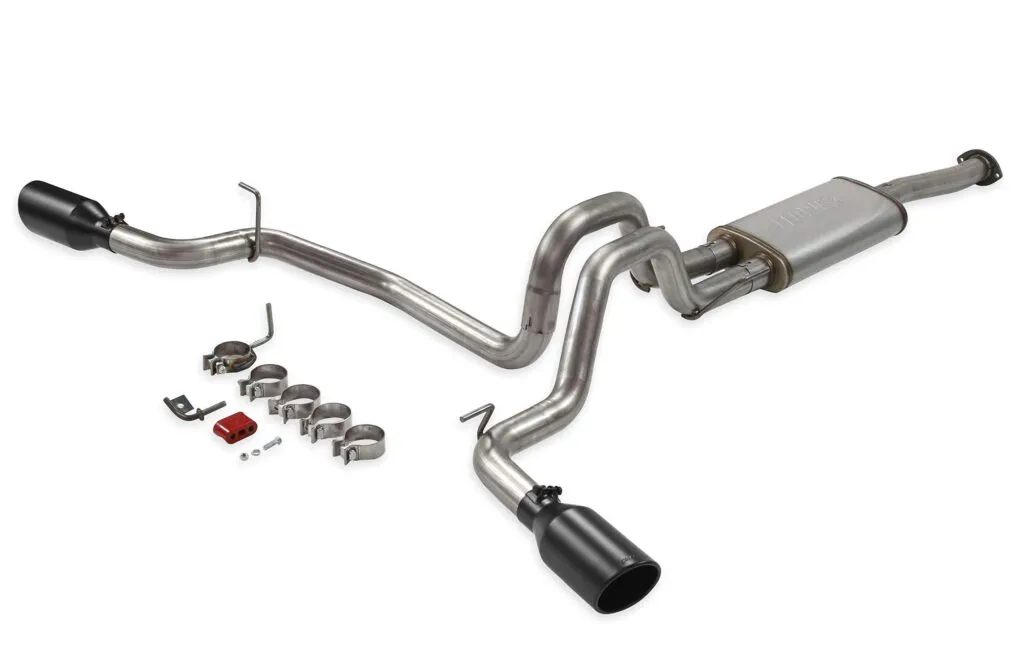
Cat-back exhaust systems are popular among many different types of vehicles, but they are particularly popular among sports cars, muscle cars, and trucks.
2.Axle-back Exhausts:
An axle-back exhaust system replaces the muffler and tailpipe. These systems are a popular choice for those looking to improve the sound of their exhaust without making significant changes to the rest of the system. They also provide a noticeable increase in horsepower and torque.
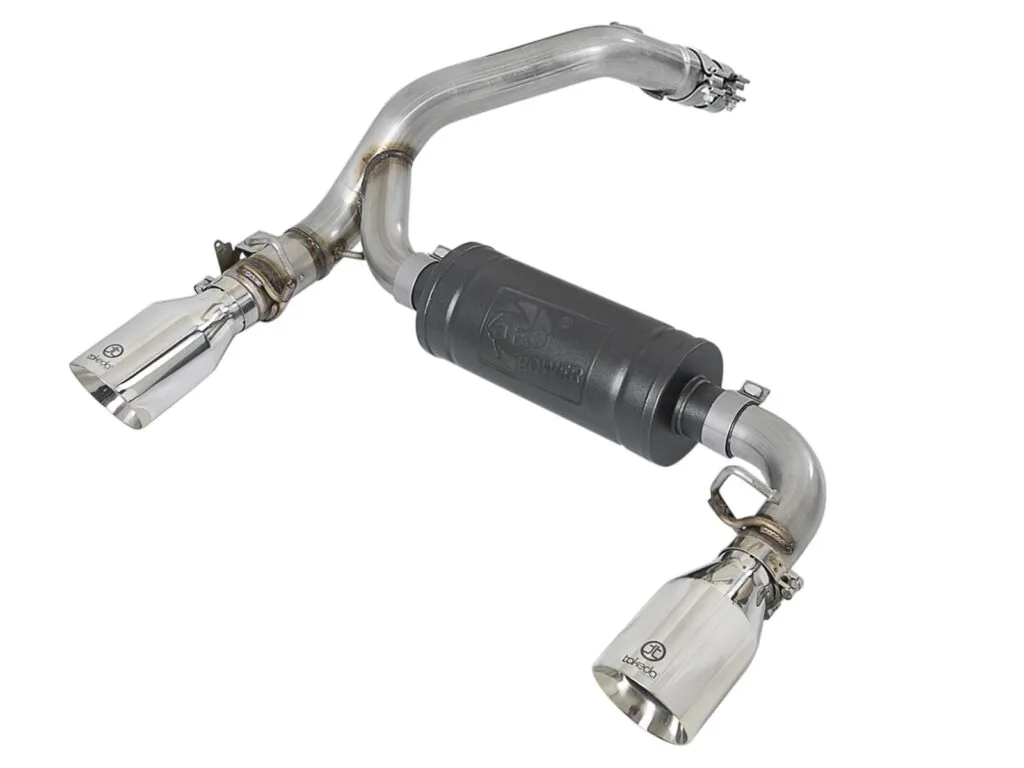
Axle-back exhaust systems are popular among many different types of vehicles, but they are also particularly popular among sports cars, muscle cars, and trucks.
3.Downpipe and Midpipe Exhausts:
A downpipe and midpipe exhaust system replaces the pipe that runs from the turbocharger to the catalytic converter. These systems are typically used by those looking to increase horsepower and torque, but they can also make the exhaust note louder and more aggressive.
Downpipe and midpipe exhaust systems are popular among many different types of vehicles, but they are particularly popular among sports cars, muscle cars, and trucks, and also among high-performance and modified vehicles.
4.Turbo-back Exhausts:
A turbo-back exhaust system replaces the entire exhaust system from the turbocharger all the way to the tailpipe. These systems are designed to improve exhaust flow, reduce backpressure, and increase horsepower and torque. They also provide a deep and aggressive exhaust tone.
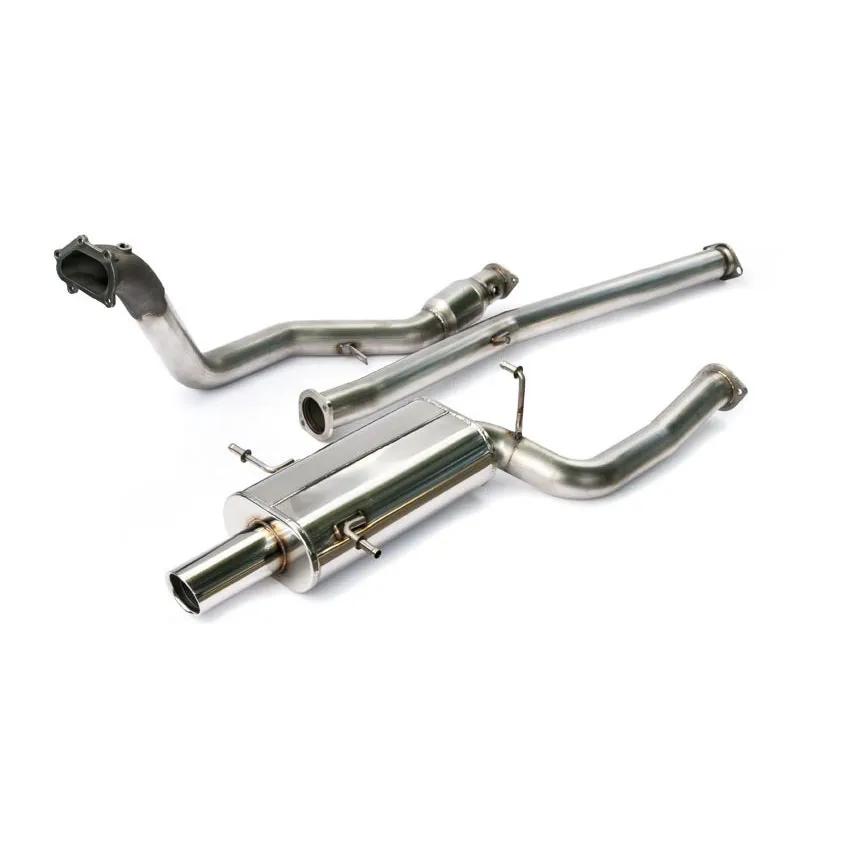
Turbo-back exhaust systems are popular among many different types of vehicles, but they are particularly popular among sports cars, muscle cars, and trucks, and also among high-performance and modified vehicles. They are also commonly found in turbocharged vehicles such as sports cars, hatchbacks, sedans and even trucks.
5.Header-back Exhausts:
A header-back exhaust system replaces the entire exhaust system from the header to the tailpipe. These systems are typically used by car enthusiasts who want to maximize their vehicle’s performance. They provide the greatest gains in horsepower and torque, but they can also make the exhaust note louder and more aggressive.
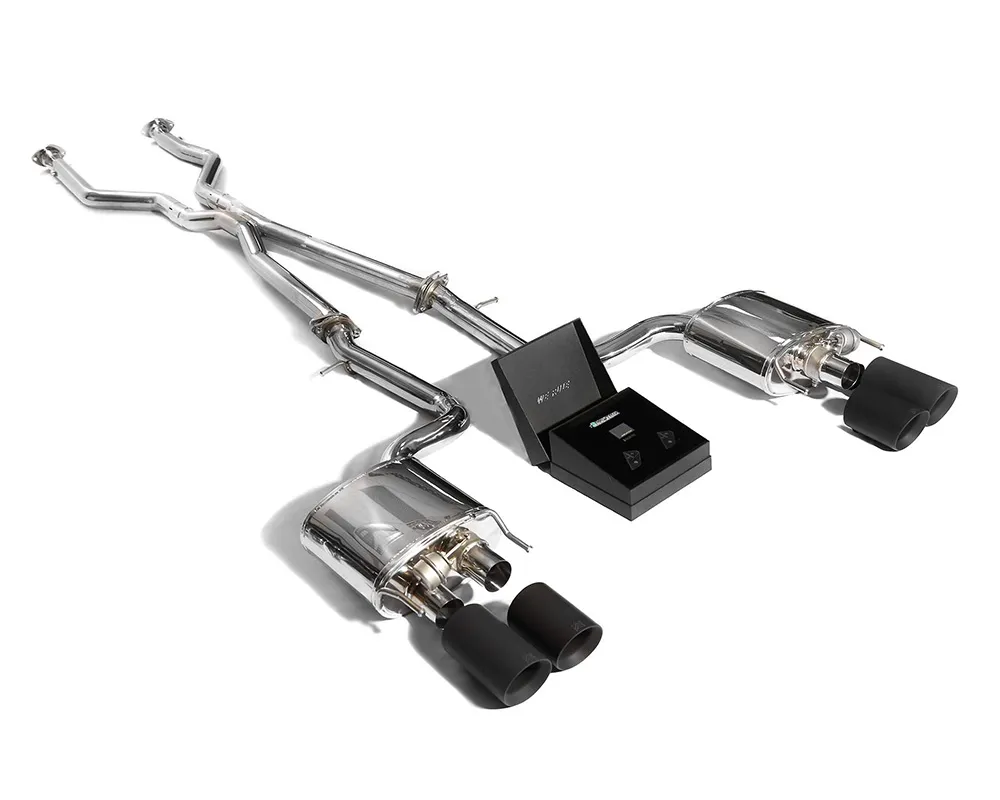
Header-back exhaust systems are popular among many different types of vehicles, but they are particularly popular among sports cars, muscle cars, and trucks, and also among high-performance and modified vehicles. They are also commonly found in high-performance vehicles and racing applications such as sports cars, hatchbacks, sedans, and even trucks that have been modified to increase horsepower and torque.
It’s important to note that not all exhaust systems are legal in all areas, it’s best to check with your local laws and regulations before buying exhaust systems.
Factors to Consider When Buying an Exhaust System
When buying an exhaust system, there are several factors to consider to ensure that you get the best system for your vehicle and your needs.
1.Type and Performance : The first thing to consider when selecting an exhaust system is the type and performance. These two factors are closely related, as the type of exhaust system you choose will have an impact on the performance of your vehicle.
When making your selection, you’ll need to decide whether you want an Axle-Back exhaust system, a Cat-Back system, or a full Header-Back fitment.
We’ve previously discussed that an Axle-Back system will offer a minimal increase in performance, while a Header-Back system will provide the highest level of performance improvement. This is due to the fact that a Header-Back system includes more tubing and components, which results in better gas flow and increased performance.
Ultimately, the choice of exhaust system will depend on the level of performance you’re looking to achieve.
2.Compatibility with your vehicle make and model: It’s important to ensure that the exhaust system you choose is specifically designed for your make and model of vehicle. This will ensure proper fitment and maximum performance gains.
3.Materials and construction quality: The quality of the materials and construction of the exhaust system is important to ensure durability and longevity. Look for systems made from high-quality materials such as stainless steel or titanium, and ensure that the system is constructed with precision and care.
4.Sound level and tone: The sound level and tone of the exhaust system is an important consideration, especially if you want a more aggressive or sporty sound. It’s important to find a system that produces the tone you’re looking for, but also keep in mind the regulations and laws of your area.
5.Price and budget: Exhaust systems can vary greatly in price, so it’s important to set a budget and consider the cost of the system in relation to the benefits it offers. Keep in mind that more expensive systems may offer higher quality materials and construction, but they may also have more features that you don’t need.
By considering these factors, you can narrow down your options and find the best exhaust system for your vehicle and your needs. It’s also essential to check with your local laws and regulations before buying exhaust systems, to ensure they are legal in your area.
How to Choose the Right Exhaust System
When choosing an exhaust system, it’s important to match the system to your needs and preferences, as well as your vehicle’s performance level.
1.Determine the best exhaust system for your needs and preferences: Consider the benefits you’re looking for, such as increased horsepower and torque, better fuel economy, or a more aggressive exhaust tone. Also, consider the sound level and tone you want, and the legal regulations of your area.
2.Match the exhaust system to your vehicle’s performance level: Consider the current performance level of your vehicle and the type of driving you do. If you’re looking to make significant performance gains, a turbo-back or header-back exhaust system may be the best option. If you’re looking for a more subtle improvement, a cat-back or axle-back exhaust system may be a better choice.
3.Research and read reviews: Research the different exhaust systems available for your vehicle, and read reviews from other customers to get an idea of the quality and performance of the system. This will help you to make a more informed decision.
4.Check the warranty and return policy: Make sure you understand the warranty and return policy of the exhaust system you’re considering. Some systems come with a limited warranty, while others may not have any coverage at all. If a return policy is available, make sure you understand the terms and conditions.
By following these steps, you can ensure that you choose the right exhaust system for your vehicle and your needs. Remember to check with your local laws and regulations before buying exhaust systems, to ensure they are legal in your area.
Installation and Maintenance
Installing an aftermarket exhaust system can be a complex process that requires specialized knowledge and tools. It is recommended to have a professional mechanic to install the exhaust system for you.
They will have the expertise and the tools necessary to install the system correctly, and ensure that it is properly aligned and tightened.
Maintenance: Proper maintenance is important to prolong the life of your exhaust system and ensure that it continues to perform at its best.
Here are a few tips for maintaining your exhaust system:
- Inspect your exhaust system regularly for signs of damage or wear, such as leaks, rust, or loose connections.
- Keep your exhaust system clean by removing any debris that may have accumulated on it.
- If you notice any problems with your exhaust system, have it inspected and repaired as soon as possible.
- Use high-temperature paint to protect your exhaust system from rust and corrosion.
It’s also essential to check with your local laws and regulations before buying exhaust systems, to ensure they are legal in your area.
By following these tips, you can help ensure that your exhaust system continues to perform at its best and lasts for a long time.
Conclusion
An exhaust system is a crucial component of your vehicle that plays a significant role in the performance, efficiency and safety of your car. Upgrading to a performance exhaust system can bring a host of benefits, including increased horsepower, better fuel economy, and a more aggressive exhaust tone.
In this Complete Buying Guide for Exhaust Systems, we have covered the different types of exhaust systems available, the factors to consider when making your purchase, and how to choose the right one for your vehicle. We also discussed the process of installation and maintenance of an exhaust system.
When choosing an exhaust system, it’s important to match the system to your needs and preferences, as well as your vehicle’s performance level. Proper research and understanding the legal regulations of your area will help you make a more informed decision.
Keep in mind that even the best exhaust system requires proper maintenance to prolong its life and ensure that it continues to perform at its best.
It’s always essential to make sure that the exhaust system you choose is legal in your area. Remember to check with your local laws and regulations before buying exhaust systems to avoid any legal issues.
As always, you can consult with professionals for more information and guidance on selecting and installing the best exhaust system for your vehicle.
We trust that you found our article, “Ultimate Buying Guide for Exhaust System” informative and beneficial. We hope that it helped you make a well-informed decision when it comes to choosing the best Exhaust system for your vehicle.
If you found it helpful, we would greatly appreciate it if you could share it on social media platforms such as , Twitter, LinkedIn, Pinterest, and Facebook using the share buttons at the top and bottom of the article.
If you have any questions or comments, please feel free to add them in the comment section below. We would be delighted to hear your thoughts and will respond promptly.
Keep an eye out for more updates and thank you for reading.

Vicky Dwaj, Author at Upgrade My Rig, is an automobile engineer passionate about pickup trucks and accessories. Follow his journey to discover the latest trends in off-road accessories, cars, and truck parts.

